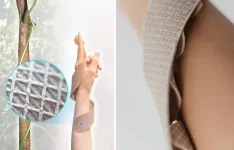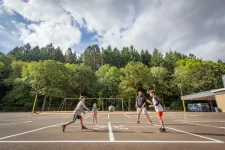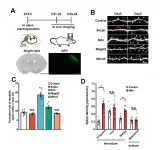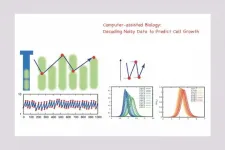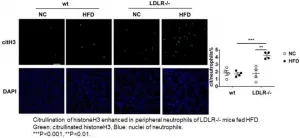(Press-News.org) To splice or not to splice...
In an article published in the journal RNA, Karan Bedi, a bioinformatician in Mats Ljungman's lab, Department of Radiation Oncology at the University of Michigan Medical School, investigated the efficiency of splicing across different human cell types. The results were surprising in that the splicing process appears to be quite inefficient, leaving most intronic sequences untouched as the transcripts are being synthesized. The study also reports variable patterns between the different introns within a gene and across cell lines, and it further highlights the complexity of how newly transcripts are processed into mature mRNAs.
Several processes take place to produce mature mRNAs that then can be exported to the cytoplasm and used as a template for protein synthesis. After initiation of transcription and the go-ahead of elongation to produce the pre-mRNA, introns need to be spliced out and the protein-coding exons connected. At first, pre-mRNA is made as a complementary sequence of the DNA but with slightly different chemistry and includes all the introns. Then the spliceosome machinery, made up of about 300 proteins, assembles "co-transcriptionally" at each intron junction as the RNA emerges from its synthesis. "Splicing is an incredibly complex process because of the great number of proteins involved that repeatedly need to assemble and disassemble at each junction. Also, the speed at which transcription generates RNA is quite fast so the splicing process has to be well organized. Many steps can go wrong and lead to various pathologies, which is why it is so important to have a better understanding of how splicing happens and how it is regulated," said Bedi.
The team started their study by analyzing the large set of Bru-seq data that the Ljungman lab has accumulated over the last 10 years and settled on six cell lines that had deep enough data for a comprehensive analysis of splicing efficiencies genome-wide. The Bru-seq technology was developed in the Ljungman lab and is based on the selective capturing of newly synthesized RNA tagged with bromouridine. Once collected, the nascent Bru-labeled RNAs were sequenced at the University of Michigan Advanced Genomics Core, and Bedi used a custom-designed computational analysis pipeline to analyze the splicing efficiencies across these data sets.
"You have to be able to use samples with a sufficient read-depth to analyze the splicing efficiencies at the junctions between introns and exons," explained Bedi. To do so, he combined sequencing data from many experiments.
In addition to the 300 proteins that remove the introns, other regulating factors participate in the splicing process. The authors identified a number of RNA-binding proteins that have been shown to have variable degrees of binding to introns, or the exon, or to the junction between them.
Bedi concluded his interview with a puzzling question opened for investigation: to have a protein, the cell needs mRNAs that are properly spliced. Why, then, would the cell waste so much energy into making RNAs that are imprecisely spliced? Ljungman points out that the inclusion of introns in our genes has served an important purpose during the evolution of higher eukaryotes in that it allowed for an increased protein diversity by the "re-shuffling" of the coding exon sequences. "If splicing was fully accurate and efficient every time, the diversity of protein-coding sequences would be much lower and thus, we believe, evolution must have shaped a certain degree of 'sloppiness' into the splicing process. Our study is the most comprehensive study of co-transcriptional splicing genome-wide to date and it clearly documents the variability of the splicing process across genes and cell types," added Ljungman.
Splicing is an area of research where much is still to be explored and discovered. Fundamental biology questions and technology development go hand in hand to find answers that contribute to the understanding of the splicing process and for the development of cures for various diseases caused by aberrant splicing.
Mats Ljugman is Professor of Radiation Oncology and of Environmental Health Sciences, and director of the Bru-Seq lab. He is also co-director of the University of Michigan Center for RNA Biomedicine of which the Bru-Seq lab is one of its two core facilities. Areas of expertise of this lab are RNA isolation, cDNA library preparation, and sequencing data analysis. The Bru-Seq lab serves researchers from the University of Michigan, and other institutions in the United States and around the world.
INFORMATION:
Cited publication: "Cotranscriptional splicing efficiencies differ within genes and between cell types," Karan Bedi, Brian Magnuson, Ishwarya Venkata Narayanan, Michelle T. Paulsen, Thomas E. Wilson, and Mats Ljungman, RNA July 2021 27: 829-840; Published in Advance May 11, 2021, doi:10.1261/rna.078662.120
Researchers at the University of Freiburg and the University of Stuttgart have developed a new process for producing movable, self-adjusting materials systems with standard 3D-printers. These systems can undergo complex shape changes, contracting and expanding under the influence of moisture in a pre-programmed manner. The scientists modeled their development based on the movement mechanisms of the climbing plant known as the air potato (Dioscorea bulbifera). With their new method, the team has produced its first prototype: a forearm brace that adapts to the wearer and which can be further developed for medical applications. ...
Recess quality, not just the amount of time spent away from the classroom, plays a major role in whether children experience the full physical, mental and social-emotional benefits of recess, a new study from Oregon State University found.
"Not all recess is created equal," said William Massey, study author and an assistant professor in OSU's College of Public Health and Human Sciences. With schools returning to full-time in-person classes this fall, he said, "Now is a good time to rethink, 'How do we create schools that are more child-friendly?' I think ensuring quality access to play time and space during the school day is a way we can do that." ...
A research group including Kobe University's Professor TAKUMI Toru (also a Senior Visiting Scientist at RIKEN Center for Biosystems Dynamics Research) and Assistant Professor TAMADA Kota, both of the Physiology Division in the Graduate School of Medicine, has revealed a causal gene (Necdin, NDN) in autism model mice that have the chromosomal abnormality (*1) called copy number variation (*2).
The researchers hope to illuminate the NDN gene's molecular mechanism in order to contribute towards the creation of new treatment strategies for developmental disorders including autism.
These research results were published in Nature Communications on July 1, 2021.
Main Points
The research ...
Although Covid-19 affects men and women differently, the large majority of current clinical studies of SARS-CoV-2 and COVID-19 makes no mention of sex/gender. Indeed, only a fraction, 4 percent, explicitly plan to address sex and gender in their analysis, concludes a new analysis of nearly 4,500 studies. 21 percent only take this variable into account when selecting participants while 5.4 % go as far as planning to have sex-matched or representative subgroups and samples. The article is published in Nature Communications.
During the corona pandemic, differences can be observed between men and women. Men are more vulnerable to a severe course of COVID-19; ...
Tokyo, Japan - Scientists from The University of Tokyo Institute of Industrial Science have designed a machine learning algorithm to predict the size of an individual cell as it grows and divides. By using an artificial neural network that does not impose the assumptions commonly employed in biology, the computer was able to make more complex and accurate forecasts than previously possible. This work may help advance the field of quantitative biology as well as improve the industrial production of medications or fermented products.
As in all of the natural sciences, biology has developed mathematical models to help fit data and make predictions about the future. However, because of the inherent complexities of living ...
Split liver transplantation (SLT) provides an opportunity to divide a donor liver and offer transplants to two small patients, one or both of whom could be a child. SLT, which is underused in the United States, could be used more widely to decrease the number of deaths of people on transplant waiting lists. In a new article, researchers address some of the ethical decisions that go into decisions to split a liver and provide a model to help hospitals make SLT decisions.
The article, by researchers at Carnegie Mellon University (CMU), appears in The BMJ, which is published by the Institute of Medical Ethics.
"Should a large liver always be split if it is medically safe to do so?" asks Sridhar Tayur, Professor of Operations ...
Tsukuba, Japan - A scientist from the Division of Quantum Condensed Matter Physics at the University of Tsukuba has formulated a new theory of superconductivity. Based on the calculation of the "Berry connection," this model helps explain new experimental results better than the current theory. The work may allow future electrical grids to send energy without losses.
Superconductors are fascinating materials that may look unremarkable at ambient conditions, but when cooled to very low temperatures, allow electrical current to flow with zero resistance. There are several obvious applications of superconductivity, such as lossless energy ...
Researchers from Tokyo Medical and Dental University (TMDU) identify pathways that link a high-fat diet to atherosclerosis in mice
Tokyo, Japan - It's long been known that a high-fat diet can lead to clogged arteries, but we have only recently begun to learn in detail how the process works. A new study in experimental mice could go a long way to finding treatments to keep arteries open and flowing.
In a study published this month in JACC Basic To Translational Science, researchers from Tokyo Medical and Dental University (TMDU) have continued their research into how a high-fat diet causes atherosclerosis, the fatty buildup of plaques on the walls of blood vessels that can lead to heart attacks and other vascular disease. Atherosclerosis is not as simple as fats ...
Research has shown that listening to music daily improves language recovery in patients who have experienced a stroke. However, the neural mechanisms underlying the phenomenon have so far remained unknown.
A study conducted at the University of Helsinki and the Turku University Hospital Neurocenter compared the effect of listening to vocal music, instrumental music and audiobooks on the structural and functional recovery of the language network of patients who had suffered an acute stroke. In addition, the study investigated the links between such changes and language recovery during a three-month follow-up period. The study was published in the eNeuro journal.
Based ...
The shale boom (mining of shale oil and gas) has contributed to an increase of crime rates in US states where 50-60% of the population lives in rural areas. That is West Virginia, North Dakota, and Arkansas. Especially the number of violent crimes has increased. This is the conclusion reached by economists from Ural Federal University (UrFU, Russia) and Shippensburg University of Pennsylvania (USA). The research results are published in The Extractive Industries and Society.
The researchers studied utilizes panel data from various sources and comprised all US states from 1999 to 2015. They compared the performance before and after 2007, when the shale boom occurred. Researchers made ...

